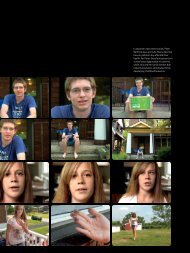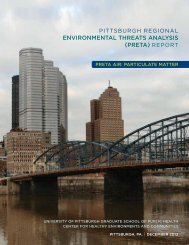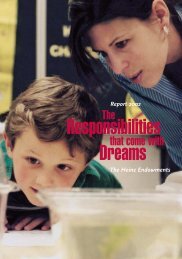View PDF - Heinz Endowments
View PDF - Heinz Endowments
View PDF - Heinz Endowments
Create successful ePaper yourself
Turn your PDF publications into a flip-book with our unique Google optimized e-Paper software.
Low-income narents and children. The problem is worse for low-income parents, who are more likely<br />
to work inegular hours when care is not available and to be less able to miss work when problems of care<br />
arise, and for their children, who are more likely to be left for reasons of convenience and cost in those<br />
forms of care that are less likely to promote academic success and appropriate social behavior.<br />
Moreover, the number of low-income children needing care has increased because of increases in poverty in<br />
general and increases in the number of low-income mothers, including single mothers, who must work<br />
because of Temporary Assistance for Needy Families (TAIIÐ. Specifically, although the number of<br />
elementary school-aged children<br />
in Allegheny County has not<br />
i<br />
changed during the last decade,<br />
the number of low-income<br />
children has increased to<br />
approximately one-third of all<br />
;iå*äö:ihäääËäiri'fr1"<br />
^òt ¡ Y¡cl<br />
srrcr_\movrngtomunlcrDalrnes _il<br />
ilEl--<br />
å f][ Æ'ñf -<br />
nonschool-hour care, but Geographíc targeting of nonschoolJtour services for low-ittcome clúldren is ineJfecsimply<br />
targeting services at tive, since pockets oÍ poverty exisl evat vithín nnre affluent tlistt'icts.<br />
impoverished inner-city<br />
neighborhoods is not sufficient, because some school districts outside the City and even elementary<br />
schools within otherwise more affluent districts have pockets of poverty. As low-income children<br />
continue to spread throughout the County, geographic targeting of services becomes less effective and<br />
unfair, so other strategies of targeting assistance must be adopted (e.g., subsidies or vouchers for<br />
individual families, sliding-fee scales and agency subsidies or reimbursements, universal programs<br />
available to all, etc.).<br />
S¡,r¿psgor oF NoNscHoor, PRocRAMS<br />
IN ALLBGHENY Cou¡qly<br />
A recent (1999) study conducted by the University of Pittsburgh Office of Child Development of<br />
nonschool-hour programs included a survey of programs and focus groups with parent participants in<br />
Allegheny County. Approximately 370 center-type programs were identified that wôuld (but not necessarily<br />
did) take school-age children during nonschool hours plus approximately 300 family and homebased<br />
care locations. Of the 139 center-based programs profiled in this survey, approximately one third<br />
were operated by social service agencies, approximately one fourth by private schools (94Vo Catholic<br />
schools), 2l%o by other organizations (e.g., Citiparks), and l47o by religious groups. However, 4lfto of<br />
programs were located in (if not operated by) schools, the majority of which were Catholic schools.







